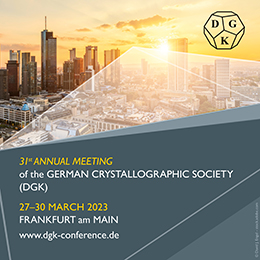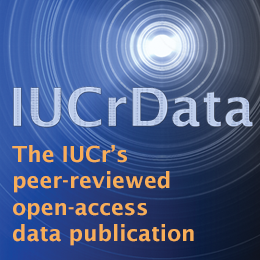
History of crystallography
René-Just Haüy and the birth of crystallography
![Thumbnail [Thumbnail]](https://www.iucr.org/__data/assets/image/0008/155546/thumbnail.jpg)
In 1784, a small book entitled Essai d'une Théorie sur la Structure des Crystaux was published marking the beginning of modern crystallography. A crystallography that departs from being purely descriptive to using mathematics. A crystallography that predicts shapes and reveals molecules that would be debated for almost a century.
Its author, René-Just Haüy, a French abbot living in Paris, at almost 40 years old, began a scientific career focused on the study of crystals. His successes made him one of the greatest scientists of his time.
To mark the bicentenary of his death, this article presents the milestones of his unusual career in the troubled historic context of the end of the 18th century. The state-of-the-art knowledge of crystallography before Haüy is demonstrated. Then, Haüy's work is highlighted from the birth of a myth to that of a theory that made crystallography and mineralogy real sciences like physics and chemistry. Finally, without neglecting the criticisms of the German scientists, the heritage of Haüy's theory is developed with the works of Delafosse and Bravais.
![[Fig0_Hauy_intro]](https://www.iucr.org/__data/assets/image/0008/155591/Fig0_Hauy_intro.jpg)
René-Just Haüy, an uncommon course
Haüy: one name, two brothers, two great men
René-Just Haüy was born on 28 February 1743 in Saint-Just-en-Chaussée, a small town located 100 km north of Paris. His parents were modest linen weavers. On 13 November 1745, they had another child, Valentin (Fig. 1, left and middle). Valentin is rather well-known outside of scientific circles for his work on behalf of blind people. A brilliant mind, he learned Latin, Greek, Hebrew and a dozen modern languages. Scandalized by the lack of consideration of society towards young blind people, he decided to act to improve their lot. In 1786, he founded what was to become the French 'Institut National des Jeunes Aveugles' (INJA). He made relief prints on paper that enabled blind people to learn to read. This new method inspired one of his students, Louis Braille, who invented the so-called Braille writing system.
René-Just Haüy is much less well-known. Like his brother, he showed keen intelligence, leading him to teach and preach. His attendance at the Royal Botanical Garden (the forerunner of the National Museum of Natural History) led to his interest in crystals and crystallography. After a long gestation period, this discipline began to emerge at the beginning of the 18th century and made significant progress in the description of minerals. Haüy revolutionized crystallography with a theory that, from success to success, made him one of the greatest scientists of his time.
The two Haüy brothers lived their last years together, in a certain degree of discomfort, and died in the same year, 1822, on 19 March for Valentin and on 1 June for René-Just. They are both buried in Paris in the Père Lachaise cemetery (Fig. 1, right).
![[Fig1_Hauy]](https://www.iucr.org/__data/assets/image/0009/155592/Fig1_Hauy.png)
From church to crystals
Nothing seemed to predestine Haüy to all the activities he carried out. His path seemed to be all mapped out, but it was not.
From the first years of his life, he showed a certain disposition to piety that never left him. Because of his singular enjoyment of religious ceremonies and songs, coupled with his quick wit and intelligence, the prior of the Premonstratensian abbey of Saint-Just asked some monks to teach him some lessons. Impressed by the child's skills as young as six years old, the prior convinced his mother to move to Paris so that René-Just could receive a proper education. In 1749, the family moved to a street near the church of Saint-Eustache in the center of Paris. For a few years, he was a chorister at the Saint-Paul church (Faubourg Saint-Antoine). During his childhood years, he practiced singing, harpsichord and violin, and developed his talent for music. Then, with the help of recommendation letters written by the prior of the Abbey of Saint-Just-en-Chaussée, he obtained a scholarship to study theology at the Collège de Navarre (Fig. 2, left). He was tonsured at the age of 19. Two years later, he became regent of fourth grade in the same college where he taught grammar and where he also attended the lectures of the Academician Mathurin Jacques Brisson. This course led him to develop a real interest in physics experiments, especially in electricity and magnetism.
![[Fig2_Hauy]](https://www.iucr.org/__data/assets/image/0010/155593/Fig2_Hauy.png)
At the age of 27, he was ordained a priest and then moved to the Cardinal Lemoine College where he taught Latin. He became friends with his colleague, the abbot Charles Lhomond (1727–1794), who had a passion for botany that he succeeded in sharing with Haüy. As the Jardin royal des Plantes (Royal Botanical Garden) was close to the Cardinal Lemoine College, Haüy and Lhomond visited it almost daily. During these visits, Haüy met Louis Daubenton (1716–1799), the collaborator of Buffon, the director of the Jardin (Fig. 2, middle). Daubenton introduced him to mineralogy and directed him towards crystallography, which was in development thanks to the work of Romé de L'Isle.
In 1779, at 36 years old, he submitted to Daubenton his personal work on the formation of garnet and calcareous spar crystals based on a layer-by-layer model (Fig. 2, right). The two memoirs he wrote of these minerals were read at the Academy in 1781 and received a favorable reception. A great career had begun...
From successes to perils
Haüy's first works quickly gave him a great reputation and an amazing rise in recognition. About two years after their publication, he was appointed to the Académie des Sciences, in botany, on 15 February 1783, as no place was available among the physicists.
The year after, he published his famous Essai d'une Théorie sur la Structure des Cristaux Appliquée à Plusieurs Genres de Substances Cristallisées (Fig. 3, left). In 1784, he retired as a teacher (regent) to devote himself entirely to crystallography. He was then 41 years old.
In 1785, under the advice of Lavoisier, Louis XVI promulgated a new academic status, and Haüy became assistant botanist in the class of Natural History and Mineralogy. He was then employed at the Academy's library.
![[Fig3_Hauy]](https://www.iucr.org/__data/assets/image/0011/155594/Fig3_Hauy.png)
The French Revolution brought him into new organizations that were recruiting scientists. For example, Haüy was appointed to the Temporary Committee on Weights and Measures and the Metric System (1793), where he participated with Lavoisier in the definition of the kilogram (Fig. 3, right). Furthermore, he taught at the École Normale de l’An III (1794). He was also a member of the National Institute, which replaced the Academy of Sciences in 1795. That same year he was appointed curator and professor at the École des Mines.
The French Revolution was also a dangerous period. Indeed, Haüy was a refractory priest (one who refused to sign an oath of loyalty to the state and before the Pope) and was arrested on 12 or 13 August 1792. He was imprisoned in the Saint-Firmin seminary, located next to the Cardinal Lemoine College. Thanks to the tenacious intervention of Etienne Geoffroy Saint-Hilaire, his loyal student and friend who was totally frightened by the situation, Haüy was quickly released. Later, thanks to the revolutionary Eloi-Nicolas Lemaire, a professor at the Collège Cardinal Lemoine, he obtained a certificate of civism. Thus, Haüy escaped the September massacres; at Saint-Firmin, almost 80% of the prisoners were murdered on the morning of 3 September.
In 1801, with the help of the École des Mines, Haüy published the Traité de Minéralogie, his first major book. Success was not long in coming.
An imperial consecration
The First Consul, Bonaparte, had great esteem for Haüy. In 1802, he demanded his appointment as honorary canon of Notre-Dame de Paris. The same year, he agreed to his appointment as professor of mineralogy at the Museum of Natural History ('jardin des plantes'). In 1803, he asked Haüy to write a book on elementary physics for the mathematics classes in national high schools (Fig. 4, left). Napoleon Bonaparte was completely satisfied with the result, so he made Haüy a member of the Legion d'Honneur.
Until the beginning of the 19th century, the 20 French universities had four faculties, namely Theology, Law, Medicine and Arts. In 1808, Emperor Napoleon I founded the Imperial University with the aim of administering the whole French education system. The former Faculties of Arts were cancelled and divided into Faculties of Literature and Faculties of Mathematics and Physical Sciences. On 14 April 1809, nine chairs were thus created at the Faculty of Sciences of Paris (Sorbonne), including that of Mineralogy, which was offered to Haüy (see the schedule of the various courses opened in April 1811 in Fig. 4, middle). He accepted, on condition that he kept his post at the Museum and was assisted by Alexandre Brongniart (1770–1847). The creation of this first chair of Mineralogy at the Sorbonne represents the origin of the Laboratory of Mineralogy of Paris, which then became the Laboratory of Mineralogy and Crystallography of Paris (LMCP), currently called the Institute of Mineralogy, Physics of Materials and Cosmochemistry (IMPMC) of Sorbonne University.
![[Fig4_Hauy]](https://www.iucr.org/__data/assets/image/0003/155595/Fig4_Hauy.png)
From honors to honors to a mixed ending
On the title page of his Essai (Fig. 3, left), Haüy introduced himself as a member of the Royal Academy of Sciences, Professor of Humanities at the University of Paris.
Thirty-eight years later, his Traité de Cristallographie (Fig. 4, right) tells us that he is "an honorary Canon of the Metropolitan Church of Paris, a Member of the Legion of Honor, a Knight of the Order of St. Michael of Bavaria, a member of the Royal Academy of Sciences, Professor of Mineralogy at the Jardin du Roi and at the Paris Academy of Sciences, of the Royal Society of London, of the Imperial Academy of Sciences of Saint Petersburg, of the Royal Academies of Sciences of Berlin, Stockholm, Lisbon and Munich; of the Geological Society of London, the Imperial University of Wilna, the Helvetian Society of Scrutineers of Nature, and that of Berlin; of the Mineralogical Societies of Dresden and Jena, the Batave Society of Sciences of Harlem, the Italian Society of Sciences, the Philomathic Society of Paris, etc."
What a career! And yet, at the end of his life, Haüy was somewhat embarrassed. He had lost part of the emoluments he had received under Napoleon's empire and shared his home with his niece and her husband, as well as his ruined brother.
On 1 June 1822, René-Just died as a result of a fall and an untreated fracture of the neck of a femur. His funeral took place on 3 June. The same year, 1822, the second edition of his Traité de Minéralogie and the three-volume Traité de Cristallographie were published.
Crystals before Haüy, a long gestation period
A name coming from the cold
The history of crystallography is marked by two minerals that have intrigued scientists and curious people by their shape and physical appearance.
The first is a variety of quartz, rock crystal, which is found in mountains, mostly as colorless and transparent crystals. The word 'crystal' comes from the ancient Greek word 'kryos', meaning cold, from which krustallos is derived, which means clear ice. In the Ancient World, people often thought by analogy: similar things had to share similar substance. If we consider ice, for example, the first observations about its appearance are its transparency and its lack of color.Quartz is a very common mineral, which makes up sand, sandstone, agates and chalcedonies. It exists in several varieties: when it is purple, it is amethyst; when it is yellow, it is citrine; when it is black, it is morion quartz; when it is grey, it is smoky quartz; and, finally, when it is transparent and colorless, it looks like ice and becomes rock crystal. Quartz also has another characteristic, it is often found with close geometric shapes. At the beginning of our era, Pliny the Elder (23–79) (see Fig. 5) had already noted this matter of fact and wondered in his Natural History (78):
"It is not easy to understand why it has six angles and six faces, especially as the angles do not always have the same appearance. As for the polish of the faces, it is such that no art can equal it."
This frequency of angles and faces has resulted in the gradual naming of crystals as 'all minerals with geometric shapes'. History dictates that quartz is also the mineral for which the first law of crystallography was discovered.
![[Fig5_Hauy]](https://www.iucr.org/__data/assets/image/0004/155596/Fig5_Hauy.png)
Calcite: an incredible variety, an incredible constancy
Calcite is the other major mineral in crystallography, first due to the spectacular variety of its natural crystal habits (Fig. 6). It appears in caves as stalactites, stalagmites or abundant aggregates. In mines, it is often found with numerous angular shapes. At the beginning of the 20th century, 2544 different shapes of calcite crystals were inventoried.
Calcite is also characterized by the shapes of its breaks (fractures), well-known to miners. These fractures show similar shapes, i.e. rhombohedra, a constancy that contrasts with the amazing variety of crystals and concretions.
As early as the 16th century, this constancy began to intrigue some minds. Nicolas-Claude Fabri de Peiresc (1580–1637), whose nickname was the prince of the curious, "discovered near Aix […] some rhomboid stones, either red or crystalline, of the talc species or transparent stone. These stones, found at Rians, are remarkable, in that when they are resolved into small pieces, each of these pieces retains the Rhomboid figure."
![[Fig6_Hauy]](https://www.iucr.org/__data/assets/image/0005/155597/Fig6_Hauy.png)
Crystallography, the birth of a name
The heritage of antiquity, with Aristotle, was the idea that minerals did not have their own shapes; only plants and animals could claim them. Mineral forms were accidental: they had to be generated by the environment, the angular shapes of minerals being only particular cases. This idea persisted until the end of the 18th century, a time when the science of crystals was emerging. As Buffon (1707–1788) wrote: "All the work of crystallographers will only serve to demonstrate that there is only variety wherever they suppose uniformity: their multiplied observations should have convinced them of this and reminded them of this very simple metaphysics which shows us that in nature there is nothing absolute, nothing perfectly regular. It is by abstraction that we have formed the geometrical and regular figures, and consequently we must not apply them as real properties to the productions of nature, whose essence may be the same in a thousand different forms" (Buffon, 1783–1788).
On the other hand, some observers were disturbed by the frequency of similar angular shapes in certain minerals, such as quartz. Yet in the 16th century, the Dutch scholar Boethius de Boodt (1609) wondered about stones "which seem to derive their accidental shape from the intrinsic essence".
At the beginning of the 18th century, more and more scientists became interested in angular shaped stones. In 1723, the Swiss scientist Moritz Anton Cappeller (1685–1769), inspired by the increasing use of the term 'crystals' for these stones, coined the word 'crystallography' in the title of his book, in which he recognized nine main shapes among the crystals (Fig. 7).
![[Fig7_Hauy]](https://www.iucr.org/__data/assets/image/0006/155598/Fig7_Hauy.png)
Erring ways and success of a bad idea
One of the great challenges of the 18th century was to classify natural productions. The Swedish scientist Carl Linnaeus (1707–1778) or von Linné (after his ennoblement in 1762) is very famous for his work Systema Naturae, published between 1735 and 1770, where he classified animals and plants by species, families, orders and classes (Fig. 8, left). For minerals, he started with the idea that crystalline shapes were useful in their classification, but he did not obtain many results.
However, the Linnaeus idea was further developed by Romé de L'Isle (1736–1790), who presented it for the first time in his Essai de Cristallographie, published in 1772 (Fig. 8, middle): "Instructed by the works of the famous von-Linné, how interesting the study of these angular forms of crystals could become... I followed them in all their metamorphoses with the most scrupulous attention; I compared the figures and the descriptions that the Swedish Naturalist had given with the originals that I possessed, I discovered several species that were missing; I cut and modeled in clay those that I had not been able to obtain in nature; finally I succeeded in forming a picture that presents the whole and the result of all that is known today on this subject."
![[Fig8_Hauy]](https://www.iucr.org/__data/assets/image/0007/155599/Fig8_Hauy.png)
How geometry was introduced in crystallography
The description of crystals had been succinct for a long period, often based on what was seen at first sight. Sometimes, angles were emphasized. Most often, the face shapes were privileged, and 'square' and 'hexagon' were used to qualify angular shaped stones. Volumes were rarely considered.
In his Essai de Cristallographie, Romé de L'Isle began a systematic description of crystalline shapes (Fig. 8, right). He was much more precise than the crystallographers who had preceded him. He introduced and generalized the vocabulary of geometry. Then, polygons, polyhedra, rhomboids, prisms, pyramids and cubes definitely appeared in the vocabulary of crystallography.
From one crystal to another
In 1773, the Swedish chemist Torbern Olof Bergman (1735–1784) published his only article on crystallography, entitled On the Shape of Crystals (Bergman, 1785). Inspired by the plane fractures of calcite shown to him by his student J. G. Gahn, he showed with the help of drawings how to go from one crystal shape to another, starting from a primitive solid, a nucleus limited by faces. He assumed that crystal growth was the result of the apposition of polygonal layers (lamellae) whose dimensions can vary during the growth (Fig. 9). Using assumed truncated lamellae, he managed to describe how to go from one crystal to another.
![[Fig9_Hauy]](https://www.iucr.org/__data/assets/image/0017/155600/Fig9_Hauy.png)
Romé de L'Isle imagined that crystals were formed by the aggregation of integrant molecules, which are inaccessible to our senses, and stuck to the observation of crystals. By practicing plane cuts, called truncations, in his mind or in clay models, he confirmed the passage from one crystal form to another from a primitive solid (Fig. 10, top). He remarked that crystals could be sorted according to six primitive polyhedra: the cube, the tetrahedron, the octahedron, the rhomboidal parallelepiped (rhombohedron), the rhomboidal octahedron and the dodecahedron with triangular faces (Fig. 10, bottom).
![[Fig10_Hauy]](https://www.iucr.org/__data/assets/image/0018/155601/Fig10_Hauy.png)
How measurements were introduced in crystallography
To better illustrate the second edition of his Cristallographie, which was published in 1783, Romé de L'Isle had the idea to reproduce crystals of his collection in terracotta. He was helped, among others, by Arnould Carangeot (1742–1806), who wrote in March 1783 that he was "a novice in crystallography, [...] despairing, after several unsuccessful attempts, of not being able to render with truth a very strange form of rock crystal". He "decided to cut out while playing with a card, the angle that two of the faces formed between them. [...] Once these two faces were cut, he was surprised to find the same angle on the two opposite faces, and so successively on the other faces of the same crystal. The experiment repeated on all the crystals of rock that he had at hand, and he recognized with satisfaction that the angles were constant, [...] whatever shape the crystal had" (Fig. 11, left).
Carangeot conceived a goniometer for the angle measurements (Fig. 11, right). He concluded that "any saline, stony or metallic substance, has a polyhedral form..., which varies only by truncations more or less strong, more or less multiplied, but whose angles are constantly the same in all crystals of the same species". The law of constancy of dihedral angles was hence discovered. This is the first law of crystallography.
The most extraordinary thing about Carangeot's work is that for decades, even centuries, people had been wondering about crystalline shapes, seeing hexagons, squares and other polygons, speculating about their formation, but no one before him had ever had the idea of systematically measuring the angles between faces or the angles between edges.
![[Fig11_Hauy]](https://www.iucr.org/__data/assets/image/0019/155602/Fig11_Hauy.png)
The birth of a myth
In science, several chapters are mythological, a legend that illustrates their birth. Archimedes is said to have discovered the Archimedean upthrust in his bath and to have acclaimed it with a powerful "Eureka, I have found it!". The fall of an apple is said to have inspired Newton, resting under an apple tree, for his theory of gravitation.Crystallography also has its myth: the broken calcite crystal of M. Defrance de Croisset. In his Essai of 1784, Haüy presented it as follows: "An observation I made on a six-sided prism calcite spar, terminated by two hexagonal faces, suggested to me the fundamental idea of the whole theory in question. I had noticed that a crystal of this variety, which had detached itself by chance from a group, was broken obliquely, so that the fracture presented a clear cut... I tried if I could not make in this same prism cuts directed along other directions and after different attempts I obtained ... a rhomboid ... which occupied the middle of the prism. Struck by this observation, I took other calcareous spars, ... and I found the same rhomboidal nucleus."
Later, in 1823, Cuvier was more precise. He revealed to us that Haüy had the happy misfortune to drop a beautiful group of calcareous spar crystallized in prisms and that after having broken other crystals at his place he exclaimed "Everything is found!" (Fig. 12).
The authenticity of this event has not been proved but there is no doubt that Haüy knew the work of Bergman and Romé de L'Isle when he presented his first results to the Academy of Sciences. The anecdote of the broken calcite is, however, far from being forgotten, because it is part of those beautiful stories of science that one wants to tell and that a large consensus considers inelegant to contest.
![[Fig12_Hauy]](https://www.iucr.org/__data/assets/image/0020/155603/Fig12_Hauy.png)
The birth of a theory: the primitive shape
"The theory that I propose in this work is based on the agreement of observation with calculation, which I could not dispense with using, to treat, with some success, a matter where everything is, so to speak, proportion and regularity." (Haüy, 1784).
To explain the different shapes of a crystal, Romé de L'Isle had imagined a primitive solid that was cut along specific planes, which he called truncations. It turns out that a certain number of crystals, such as calcite, can break along planes with precise orientations: this is what is called cleavage.
Inspired perhaps by the broken crystal of M. Defrance de Croisset, Haüy developed an experimental protocol. Instead of starting from a primitive solid, he had the idea to 'dissect' the crystals, using a hammer and a knife blade, by successively removing cleavage lamellae until the crystal shape remains similar from one cleavage operation to the next. He called this shape the primitive shape. It is hidden in a crystal, but is constant for a mineral species (see Fig. 13).
From the repeated dissections applied to the crystals of his own collection and from the observations he made, Haüy concluded that there were the following primitive shapes: the parallelepiped, which includes the cube, the rhombohedron, the regular tetrahedron, the regular octahedron, the hexagonal prism and the dodecahedron with rhombic faces.
![[Fig13_Hauy]](https://www.iucr.org/__data/assets/image/0003/155604/Fig13_Hauy.png)
From the primitive shape to integrant and subtractive molecules
Haüy assumed that the mechanical division of a crystal into small solids has a limit such that any further division would distort the nature of the mineral substance. Haüy called these limit solids 'molécules intégrantes'. The shape of these molecules is that of the primitive solid when it is a parallelepiped. This is the case for halite (sodium chloride crystals) with its cubic cleavages and, of course, for calcite with its rhombohedral breaks. In these situations, Haüy could deduce, by "sine and cosine", the possible shapes of the crystal.
From cleavage to cleavage, Haüy found three possible shapes of integrant molecules (Fig. 14, left and middle), namely "the parallelepiped which is the simplest of the solids whose faces are parallel two by two, the triangular prism which is the simplest of the prisms and the tetrahedron which is the simplest of the pyramids". Then, an issue arose because the possible crystal shapes in the last two cases could not be deduced.
Thus, Haüy introduced an appropriate group of integrant molecules resulting in a parallelepiped that he called subtractive molecules (Fig. 14, right).
![[Fig14_Hauy]](https://www.iucr.org/__data/assets/image/0004/155605/Fig14_Hauy.png)
The case of fluorite
Haüy was quickly confronted with a mineral that escaped his theory: fluorite. Indeed, "in whatever way one goes about subdividing either the cube, the rhomboid, or the octahedron, one will always have solids of two forms, that is to say octahedra and tetrahedra, without ever being able to reduce the result of the division."
In other words, the 'dissections' systematically led to octahedra and tetrahedra. Haüy's theory is based on the fact that there is one and only one shape of integrant molecule for a given mineral. It is thus necessary to choose in which polyhedron the nature of the mineral is and to suppose that the structure is "as riddled with a multitude of vacuoles occupied, either by water of crystallization or by some other substance, so that if it were given to us to push the division until its limit, one of the two species of solids of which it is a question would disappear, and all the crystal would be only composed of molecules of the other form".
Moreover, it is necessary to find a parallelepipedal shape in order to recover the octahedral or cubic morphology of fluorites using Haüy's theory (Fig. 15, left). Indeed, starting from a primitive solid with either tetrahedral or octahedral shape, Haüy's theory does not lead to either an octahedron or a cube (Fig. 15, middle). According to Haüy, the subtractive molecule of fluorite is a rhombohedron formed by an octahedron and two tetrahedra, each placed on one of two opposite faces of the octahedron (Fig. 14, right). Later, in 1943, Charles Mauguin suggested an interpretation of this subtractive molecule: when considering a calcium atom in the octahedron and one fluorine atom in each tetrahedron, it exactly corresponds to the CaF2 chemical formula of fluorite (Fig. 15, right) (Mauguin, 1944).
![[Fig15_Hauy]](https://www.iucr.org/__data/assets/image/0005/155606/Fig15_Hauy.png)
From the primitive shape to all shapes
Once the primitive solid was found, Haüy used it as an 'abstract' substrate with which he predicted the possible faces with the successive apposition of lamellae constituted by joined integrant or subtractive molecules. The dimensions of the lamellae were supposed to be constant or decrease one after the other in a row often, two sometimes, three more rarely, in one, two or three of the directions of the molecule.
Haüy established his 'laws of decrements' according to their orientation: 'decrements on the edges', parallel to the edges of the primitive solid, forming steps; 'decrements on the angles', parallel to the diagonals; and the other cases being 'mixed and intermediate decrements'. According to the relative dimensions of these molecules and these laws, all the most probable faces can be predicted (Fig. 16).
Until Haüy, the objective of crystallography was the description and identification of minerals. Haüy was the first to establish a complete theory: it is based on (i) a specific experimental protocol, (ii) observations that enable one to make hypotheses about molecules, (iii) the concept of a primitive solid, (iv) and the modeling of possible faces by stacking of lamellae and molecules according to simple rational laws of decrements.
Hence, with Haüy, crystallography was extracted from natural history and became a real physical science.
![[Fig16_Hauy]](https://www.iucr.org/__data/assets/image/0006/155607/Fig16_Hauy.png)
How the law of symmetry was introduced in crystallography
Haüy used the term symmetry several times in his early writings, such as the Essai d'une Théorie sur la Structure des Crystaux. He established a law later, in 1815. He presented it as follows: "The laws of decrements whose actions on the edges and on the angles of the faces which finish the primitive shapes of minerals, ..., are subordinated to another law, to which I give the name of law of symmetry, ... Symmetry consists in the fact that the same kind of decrement is repeated on all the parts of the nucleus, whose resemblance is such that one can substitute one for the other by changing the position of this nucleus with respect to the eye, without it stops to present itself under the same aspect". In 1822, in his great Traité de Crystallographie, he attributed to his law a great importance by affirming that it is "a great law of crystallization, whose influence is communicated to the results of all the particular laws on which depend the crystal shapes. To give an idea of this, I distinguish two relative ways of being of the edges and angles of a primitive shape. Those which I call identical are one in the judgment of the eye: such are, for example, two opposite edges which have the same length and are included between faces equally inclined one on the other. The law of symmetry consists of the fact that the same kind of decrement is repeated on all the identical edges or angles, while those that are not identical may undergo another kind of decrement, or even remain free."
Haüy physicist and gemologist
The work of Haüy is not restricted to the study of crystal shapes. Very early, during the writing of his first Traité de Minéralogie at the École des Mines de Paris, he became interested in the physical properties of minerals. He started with density. The Traité exhibits an illustration of a Nicholson hydrometer, an apparatus for measuring density, consisting of a cylindrical volume closed by two cones (Fig. 17, left). Haüy was also interested in the magnetism of minerals with a compass and in the static electricity produced by friction or by heating with a kind of compass equipped with an electrifiable ball at both ends (Fig. 17, middle).
Perceived as a physicist, the revolution asked him to work on the realization of the kilogram in cooperation with Lavoisier. Realized by Jean-Nicolas Fortin, the replicas of the standard kilogram were to be distributed in all of France (Fig. 3, right). Under the request of Napoleon, in 1803, he wrote a book on elementary physics for the mathematics classes of the national high schools, which was re-edited in 1806 and 1820 (Fig. 4, left; Fig. 17, right). His skills were also used to design a book on the identification of gemstones once they had been cut. Published in 1817, this book marks the birth of modern gemology for many.
![[Fig17_Hauy]](https://www.iucr.org/__data/assets/image/0007/155608/Fig17_Hauy.png)
Numerous discoveries
Crystallography allowed Haüy to differentiate between minerals close to each other by their physical appearance and their chemical composition. This is how he reassessed the definition of Schorl, currently a species of black tourmaline (Fig. 18, left). Indeed, the name "Schorl was given to more than fifteen substances, all very different, among which was also hornblende. Thus, it was given to Tourmaline, to a variety of feldspar in small and usually white crystals, and to the `Croix de Bretagne' stone, [...] This species, the most badly defined that perhaps existed in natural history, was like a meeting (sic) of all the minerals that one was embarrassed to classify. One called them Schorls, because one had to do something with them. I tried to unravel this mess; I even substituted the name of amphibole for that of Schorl, which was vague and meaningless, and which had to be punished for all the errors it had caused in Mineralogy. I have restricted this name of amphibole to Hornblende; I have kept that of Tourmaline; I have called pyroxenes the volcanic Schorls".
Another success concerns the zeolites of the alumino-silicates, which have similar appearance and chemical formulas and which boil and give off water vapor when heated! In Haüy's time, the word zeolite designated a mineral. Haüy showed that actually they were minerals: stilbite, chabazite, mesolite (Fig. 18, right) and analcime. For stilbite, he distinguished two varieties, which were recognized in 1822 by H. J. Brooke as two species: stilbite proper and heulandite.
![[Fig18_Hauy]](https://www.iucr.org/__data/assets/image/0008/155609/Fig18_Hauy.png)
Finally, Haüy published the first description of nearly 40 minerals. Nine of them have kept the name he gave them: actinote (1801), amphibole (1797), anatase (1801), apophyllite (1808), axinite, epidote, dioptase (1797), kyanite (1801) and stilbite (1796).
Decline and revival
New discoveries
The criticisms of Haüy's theory, those that question it the most, originate from the discovery and confirmation of three phenomena: hemihedry, isomorphism and polymorphism.
Hemihedry
Exactly when Haüy stated the law of symmetry, he was aware that there were counter-examples. Some crystals, such as tourmaline, present prisms where the extremities do not respect symmetry: one is pyramidal and the other flat (Fig. 19, left and middle). Haüy saw only an apparent anomaly. In 1819, the German crystallographer Christian Samuel Weiss (1780-1856) demonstrated the generality of this phenomenon and gave it the name of hemihedry. This embarrassed Haüy.
Isomorphism
At the end of 1819, the German scientist Eilhard Mitscherlich (1794-1863) noticed that "some different elements, combined with the same number of one or more different elements, affect the same crystalline form" (Mitscherlich, 1822). As he obtained a large number of favorable results, he postulated that bodies "of the same crystalline shape can crystallize together in any proportion". This phenomenon is called isomorphism (Fig. 19, right). Frequently encountered, this was an issue for Haüy. Indeed, his theory was based on the fact that any mineral results from the stacking without voids of similar molecules. How then to explain a mineral with two different molecules? Haüy did not know how to answer this question and adopted a hostile, almost sectarian, attitude.
![[Fig19_Hauy]](https://www.iucr.org/__data/assets/image/0018/155610/Fig19_Hauy.png)
Dimorphism and polymorphism
Dimorphism corresponds to the possibility that two or more minerals have the same chemical formula. From the beginning of the 19th century, this situation was known.
Martin Heinrich Klaproth (1743-1817), for example, demonstrated that aragonite has the same composition as calcite. This situation, in disagreement with Haüy's theory, was quickly confirmed by many chemists.
Finally, Haüy conceded, without much conviction, "that it is not impossible that one would not be forced to place in distinct species minerals which would contain the same principles united between them in the same ratio, if the diversity of the reciprocal functions exerted by these principles determined one in the most remarkable properties of the minerals in question."
Criticism of Haüy's measurements
All his life, Haüy used the goniometer of Carangeot, the best accuracy of which being one-tenth of a degree. However, Haüy took certain liberties by presenting angular values with an accuracy of one second of arc (1/3600°). These values were not always in agreement with the measurements presented by other scientists. Indeed, as early as 1809, William Wollaston (1766-1828), Professor at Cambridge, developed a goniometer based on light reflections on the faces of a crystal. Its accuracy, around one minute of arc (1/60°), demonstrated the errors of Haüy's measurements, errors that he never admitted. At the end of his life, Haüy saw his influence diminish and his theory more and more questioned.
The continuous vision of matter
Another source of criticism concerns the foundations of Haüy's theory. The very hypothetical concept of integrant molecules, subtractive molecules and primitive shapes was contested.
At the beginning of the 19th century, crystal models based on the stacking of similar particles were not new. However, they were criticized by mineralogists, especially German mineralogists, who preferred a continuous description of matter. Therefore, they abandoned molecules and turned to geometry and, in particular, to the operations of symmetry that Haüy had seen but not developed enough. As Ernest Mallard (1833-1894) would later write "Geometry, introduced as a master in science, brought with it its theories and its procedures; Haüy's painful calculations were replaced by elegant and rapid calculations" (Mallard, 1879).
German mineralogists were much interested in the optical properties of minerals. They also established systematic descriptions of crystals. This allowed them, from 1808, to classify crystals into six, four, then finally seven systems. These systems are subdivided into `subsystems', called `classes', defined by point symmetry groups or by an orientation symmetry group. The two first determinations of all possible groups were made by the German crystallographers Frankenheim M. L. in 1826 and Hessel J. F. C. in 1830. They were unknown and almost forgotten, but were rediscovered later by Auguste Bravais (see https://www.iucr.org/news/newsletter/volume-27/number-1/auguste-bravais,-from-lapland-to-mont-blanc) in 1851 with what can be considered as a revival of Haüy's theory.
Delafosse and Bravais: the revival
The task of rescuing what could be saved from Haüy's theory naturally fell to his closest student, Gabriel Delafosse (1796-1878) (Fig. 20). It took him about 20 years to start to work on it. In his theory, published in 1840, he made the difference between physical molecules and integrant or subtractive molecules: "in the interior of the crystal, the molecules are symmetrically spaced, so as to present as a whole a sort of staggered configuration, or more exactly the image of a continuous lattice with parallelepipedal cells. Haüy's integrant molecule is nothing more than the smallest parallelepiped formed by neighboring molecules, marking its corners; or, if you like, it is only the representation [...] of the cell of the crystal lattice. It is therefore perfectly distinct from the physical molecule, which can have [...] a completely different shape".
Unfortunately, Delafosse's model was not really successful.
![[Fig20_Hauy]](https://www.iucr.org/__data/assets/image/0019/155611/Fig20_Hauy.png)
Things began to change in 1850 and 1851 with Auguste Bravais (1811-1863), who developed Delafosse's intuitions mathematically (Fig. 21). The results are numerous: from the demonstration of possible symmetries to the inventory of point symmetry groups, to the seven Bravais systems, the 14 Bravais lattices, and the first theories on hemihedry, face stability and twinning (defects associating two crystals). Almost unnoticed, the work of Bravais was to be recognized later, as Mallard wrote in 1879: "M. Delafosse and M. Bravais thought that there was better to do than to reject, in order to substitute a sterile geometry, the theory of Haüy, so intimately penetrated by physical reality. Thanks to their work, we can now give to the science of crystals a solid and wide enough base to carry the whole edifice".
![[Fig21_Hauy]](https://www.iucr.org/__data/assets/image/0020/155612/Fig21_Hauy.png)
Concluding remarks
The 18th century, the century of the Enlightenment, gave primary importance to reason and science. Newton's discoveries enthused philosophers like Voltaire. Mathematics described the order of the world. Apart from mechanics, astronomy and optics, few sciences at that time used mathematics. At the end of the century, a theory of crystals demonstrated how inorganic matter, which was supposed to have no form of its own, could have perfect geometrical shapes that could be calculated mathematically. The impact is substantial and Haüy is considered as a Newtonian!
His crystallography heralded a 19th century in which science was triumphant. It opened up new horizons in mineralogy, optics and chemistry, and then in the last part of the 19th century, in the physics of materials. It also introduced symmetry, one of the most important concepts in physics, which allowed Pasteur to discover molecular dissymmetry and Curie to discover the principle of symmetry.
The discoveries made during the 19th century should not let us believe that there was no resistance. The theories inspired by Haüy were not fully accepted until the discovery of X-ray diffraction in 1912. The work initiated by Romé de l'Isle and Haüy then found its completion with the X-ray diffraction experiments of Bragg, father and son. And a new era began for crystallography...
![[FigConcl_Eiffel]](https://www.iucr.org/__data/assets/image/0003/155613/FigConcl_Eiffel.png)
![[FigConcl_Hauyne]](https://www.iucr.org/__data/assets/image/0004/155614/FigConcl_Hauyne.png)
Bibliography
Bergman, M. T. (1785). De la forme des crystaux. In Opuscules Chimiques et Physiques, 2nd ed., pp. 1-27. Dijon: L. N. Frantin. Translated by M. de Moreveau.Birembaut, A. (1957). La minéralogie. In Histoire de la Science, pp. 1080. Paris: Gallimard.
Boethius de Boodt, A. (1609). Gemmarum et Lapidum Historia. Hanau: Wechel.
Boulliard, J. C. (2010). Le Cristal et ses Doubles. Paris: CNRS éditions.
Bravais, A. (1849). Mémoires sur les Systèmes Formés par des Points. Paris: Bachelier.
Bravais, A. (1851). Études Cristallographiques, pp. 101-276. Paris: Bachelier.
Bravais, A. (1866). Études Cristallographiques. Paris: Gauthier-Villars.
Buffon, G. (1783-1788). Histoire Naturelle des Minéraux. Paris: Imprimerie Royale.
Carangeot, A. (1783). Goniomètre, ou mesure-angle. In Observations sur la Physique, sur l’Histoire Naturelle et sur les Arts, 22, 193–197.
Cuvier, G. (1823). Éloge Historique de Haüy. Paris: Académie des Sciences.
Delafosse, G. (1840). Thesis, Université de Paris, France.
Delafosse, G. (1858–1862). Nouveau Cours de Minéralogie. Roret: Paris.
Haüy, R.-J. (1784). Essai d'une Théorie sur la Structure des Crystaux. Paris: Gogué & Née.
Haüy, R.-J. (1801). Traité de Minéralogie. Paris: Louis.
Haüy, R.-J. (1803). Traité Élémentaire de Physique. Paris: Delance
Haüy, R.-J. (1822). Traité de Cristallographie. Paris: Bachelier.
Haüy, R.-J. (1822). Traité de Minéralogie. Paris: Bachelier.
Haüy, R.-J. (1823). Traité de Minéralogie. Paris: Bachelier.
Les Contemporains (1904). Auguste Bravais, N. 588. Sablons: Bureau de la revue.
Linnaeus, C. (1751). Philosophia Botanica. Stockholm: Kiesewetter.
Mallard, E. (1879). Traité de Cristallographie, 1st ed. Paris: Dunod.
Mitscherlich, E. (1822). Ann. Chim. Phys. 19, 350–419.
Pliny the Elder (78 AD). The Natural History, book XXXVII, IV.
Rome De L'Isle, J.-B. (1772). Essai de Cristallographie. Paris: Didot Jeune.
The authors are located at Sorbonne Université, Muséum National d’Histoire Naturelle, UMR CNRS 7590, Institut de Minéralogie, de Physique des Matériaux et de Cosmochimie, IMPMC, Paris, France.
Copyright © - All Rights Reserved - International Union of Crystallography










